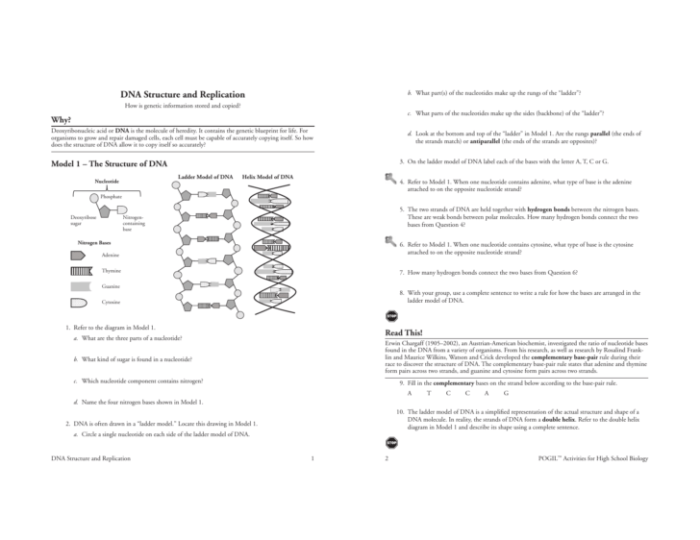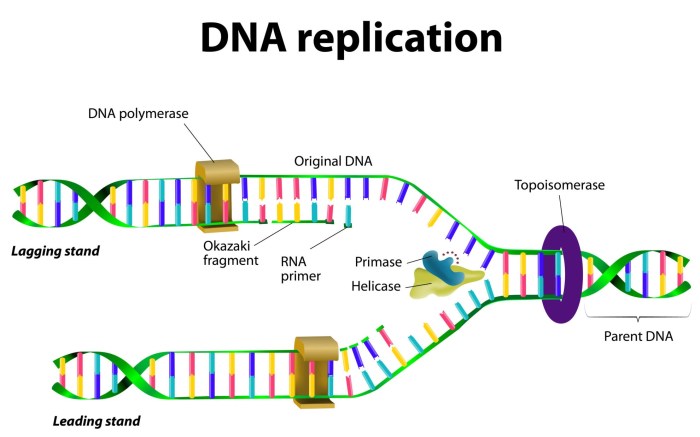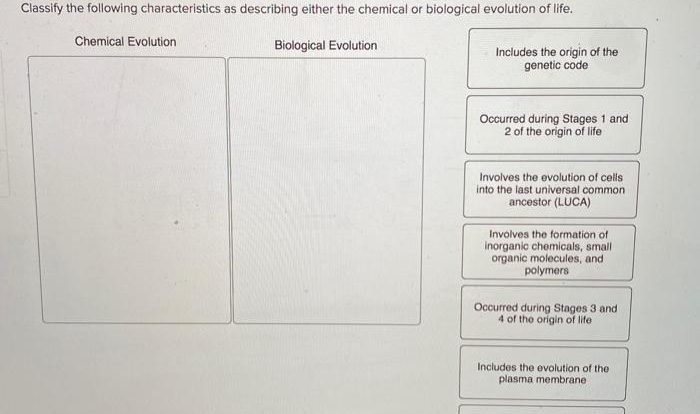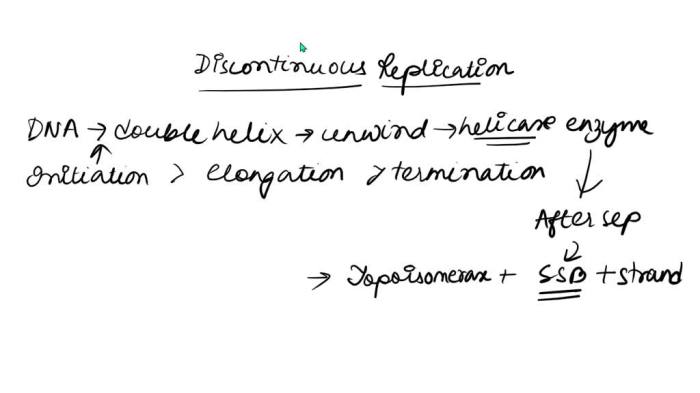Introducing the DNA replication worksheet answer key, a comprehensive guide that empowers students and researchers alike to decipher the intricacies of DNA replication. This key unlocks the secrets of this fundamental biological process, providing a thorough understanding of the steps, enzymes, and potential errors involved.
Delving into the mechanisms of DNA replication, this resource unravels the roles of key players such as DNA polymerase, helicase, and ligase. By exploring examples across diverse organisms, it highlights the variations in replication mechanisms and their implications for cell function.
DNA Replication Process Overview

DNA replication is the process by which a cell duplicates its DNA. It occurs during cell division and is essential for the transmission of genetic information to daughter cells.
The DNA replication process involves several key steps:
- Initiation:The process begins when an enzyme called helicase unwinds the DNA double helix, separating the two strands.
- Elongation:DNA polymerase, another enzyme, then adds new nucleotides to each of the separated strands, using the existing strands as templates. This process continues until the entire DNA molecule has been copied.
- Termination:Once the new DNA strands have been synthesized, an enzyme called ligase joins the ends of the strands together, creating a continuous DNA molecule.
Roles of DNA Polymerase, Helicase, and Ligase
The three main enzymes involved in DNA replication are DNA polymerase, helicase, and ligase. DNA polymerase is responsible for adding new nucleotides to the growing DNA strands. Helicase unwinds the DNA double helix, allowing DNA polymerase to access the template strands.
Ligase joins the ends of the new DNA strands together.
These enzymes work together to ensure that the DNA replication process is accurate and efficient.
DNA Replication Worksheet Answer Key
This answer key provides the correct responses to the DNA replication worksheet, along with explanations for each answer.
Worksheet Question 1: What is the complementary strand to the following DNA sequence: ATCGTACG?
Answer:TAGCATGC
Rationale:DNA strands are complementary, meaning the bases on one strand pair with specific bases on the other strand. Adenine (A) pairs with thymine (T), and cytosine (C) pairs with guanine (G).
Worksheet Question 2: What enzyme is responsible for unwinding the DNA double helix during replication?
Answer:Helicase
Rationale:Helicase breaks the hydrogen bonds between base pairs, allowing the DNA double helix to unwind and separate into two strands.
Worksheet Question 3: Which nucleotide is added to the growing DNA strand during replication?
Answer:dNTP (deoxyribonucleoside triphosphate)
Rationale:dNTPs are the building blocks of DNA and are added to the growing strand in a complementary manner by DNA polymerase.
Worksheet Question 4: What is the role of RNA primers in DNA replication?
Answer:RNA primers provide a starting point for DNA polymerase to begin synthesis of the new DNA strand.
Rationale:DNA polymerase can only add nucleotides to an existing strand, so RNA primers are used to initiate synthesis at the 3′ end of the new strand.
Worksheet Question 5: What enzyme removes the RNA primers from the newly synthesized DNA strand?
Answer:RNase H
Rationale:RNase H is an enzyme that specifically degrades RNA, removing the RNA primers from the new DNA strand.
DNA Replication Examples
DNA replication is a fundamental process that occurs in all living organisms. It is essential for cell division and the passing on of genetic information from one generation to the next. The basic mechanism of DNA replication is similar in all organisms, but there are some variations in the details of the process across species.
Prokaryotic DNA Replication, Dna replication worksheet answer key
Prokaryotic DNA replication is a relatively simple process that occurs in a single circular chromosome. The replication process begins at a specific origin of replication, and the DNA is replicated in both directions until the entire chromosome has been duplicated.
Eukaryotic DNA Replication
Eukaryotic DNA replication is more complex than prokaryotic DNA replication. It occurs in multiple chromosomes, and each chromosome has multiple origins of replication. The replication process begins at each origin of replication, and the DNA is replicated in both directions until the entire chromosome has been duplicated.
Variations in Replication Mechanisms
There are some variations in the details of the DNA replication process across species. For example, the size of the replication bubble varies between species. In prokaryotes, the replication bubble is typically about 100 kilobases in size, while in eukaryotes, the replication bubble is typically about 100 megabases in size.
Another variation in the DNA replication process is the use of different DNA polymerases. In prokaryotes, a single DNA polymerase is responsible for the entire replication process. In eukaryotes, multiple DNA polymerases are involved in the replication process.
DNA Replication Methods and Procedures
DNA replication is a fundamental process in biology, ensuring the accurate transmission of genetic information during cell division. Scientists have developed various methods and procedures to study DNA replication in the laboratory, enabling a deeper understanding of its mechanisms and regulation.
One of the key methods used to study DNA replication is in vitro DNA replication assays. These assays involve isolating DNA polymerase and other replication proteins from cells and reconstituting them in a reaction mixture containing DNA template and nucleotides. By carefully controlling the reaction conditions, researchers can study the steps involved in DNA replication, including primer binding, elongation, and termination.
DNA Sequencing and Analysis
DNA sequencing is a crucial technique for determining the nucleotide sequence of DNA molecules. This information is essential for understanding gene structure, function, and regulation. The most widely used DNA sequencing method is the Sanger sequencing method, also known as dideoxy sequencing.
In Sanger sequencing, a DNA sample is mixed with a primer, DNA polymerase, and a mixture of dideoxynucleotides (ddNTPs) and normal nucleotides (dNTPs). ddNTPs lack a 3′-OH group, which prevents further elongation of the DNA strand once incorporated. The reaction mixture is divided into four separate tubes, each containing a different ddNTP (ddATP, ddCTP, ddGTP, or ddTTP).
As the DNA polymerase synthesizes new DNA strands, it randomly incorporates ddNTPs, resulting in a series of DNA fragments of varying lengths. These fragments are then separated by electrophoresis based on their size, and the sequence is determined by reading the order of the fragments.
DNA sequencing has revolutionized the field of molecular biology, allowing researchers to study genes, diagnose diseases, and develop new therapies. It has also been instrumental in advancing our understanding of genome evolution and biodiversity.
DNA Replication Errors and Consequences
DNA replication is a crucial process for cell division and the transmission of genetic information. However, errors can occur during replication, leading to mutations in the DNA sequence.
DNA replication errors can be classified into two main types: base substitution errors and frameshift errors.
Base Substitution Errors
- Transitions:A purine (A or G) is replaced by another purine.
- Transversions:A purine is replaced by a pyrimidine (C or T), or vice versa.
Frameshift Errors
- Insertions:An extra nucleotide is inserted into the DNA sequence.
- Deletions:One or more nucleotides are removed from the DNA sequence.
Consequences of DNA Replication Errors
DNA replication errors can have significant consequences for cell function, including:
- Altered protein structure and function:Mutations in the DNA sequence can lead to changes in the amino acid sequence of proteins, potentially altering their structure and function.
- Cell cycle arrest and apoptosis:Severe DNA replication errors can trigger cell cycle arrest or apoptosis (programmed cell death) to prevent the propagation of damaged cells.
- Cancer:Accumulation of DNA replication errors over time can increase the risk of cancer development.
DNA Replication Table

The DNA replication process is a complex and precise event that ensures the faithful transmission of genetic information from one generation to the next. This table summarizes the key steps, enzymes, and errors involved in DNA replication.
The DNA replication process involves three main steps: initiation, elongation, and termination. During initiation, the DNA double helix is unwound and the replication machinery assembles at specific sites called origins of replication. During elongation, the DNA polymerase enzyme synthesizes new DNA strands complementary to the template strands.
During termination, the newly synthesized DNA strands are joined together to form two complete DNA molecules.
Enzymes Involved in DNA Replication
- Helicase:Unwinds the DNA double helix.
- Primase:Synthesizes short RNA primers that provide a starting point for DNA polymerase.
- DNA polymerase:Synthesizes new DNA strands complementary to the template strands.
- DNA ligase:Joins the newly synthesized DNA strands together.
Errors in DNA Replication
- Base-pair substitutions:Errors in which one nucleotide is replaced by another.
- Insertions:Errors in which one or more nucleotides are inserted into the DNA sequence.
- Deletions:Errors in which one or more nucleotides are deleted from the DNA sequence.
- Frameshift mutations:Errors in which the reading frame of the DNA sequence is shifted, resulting in a change in the amino acid sequence of the protein encoded by the gene.
Q&A
What is the role of DNA polymerase in DNA replication?
DNA polymerase is the enzyme responsible for synthesizing new DNA strands by adding nucleotides to the growing chain, ensuring the accurate duplication of genetic information.
How does helicase contribute to DNA replication?
Helicase unwinds the double helix structure of DNA, separating the two strands to create a replication fork, allowing access for DNA polymerase and other replication proteins.
What are the potential consequences of DNA replication errors?
DNA replication errors can lead to mutations, which can have a range of effects on cell function, including impaired protein synthesis, altered gene expression, and even cancer development.

